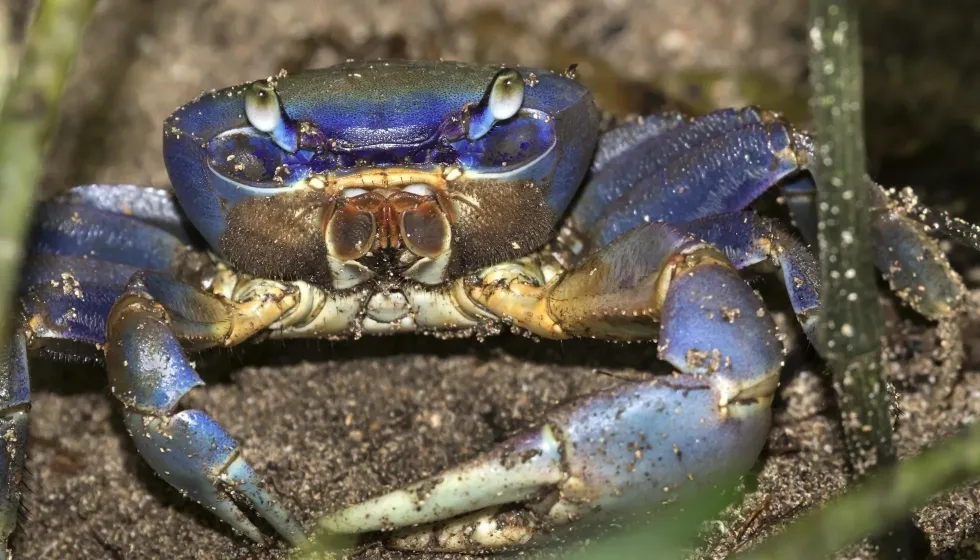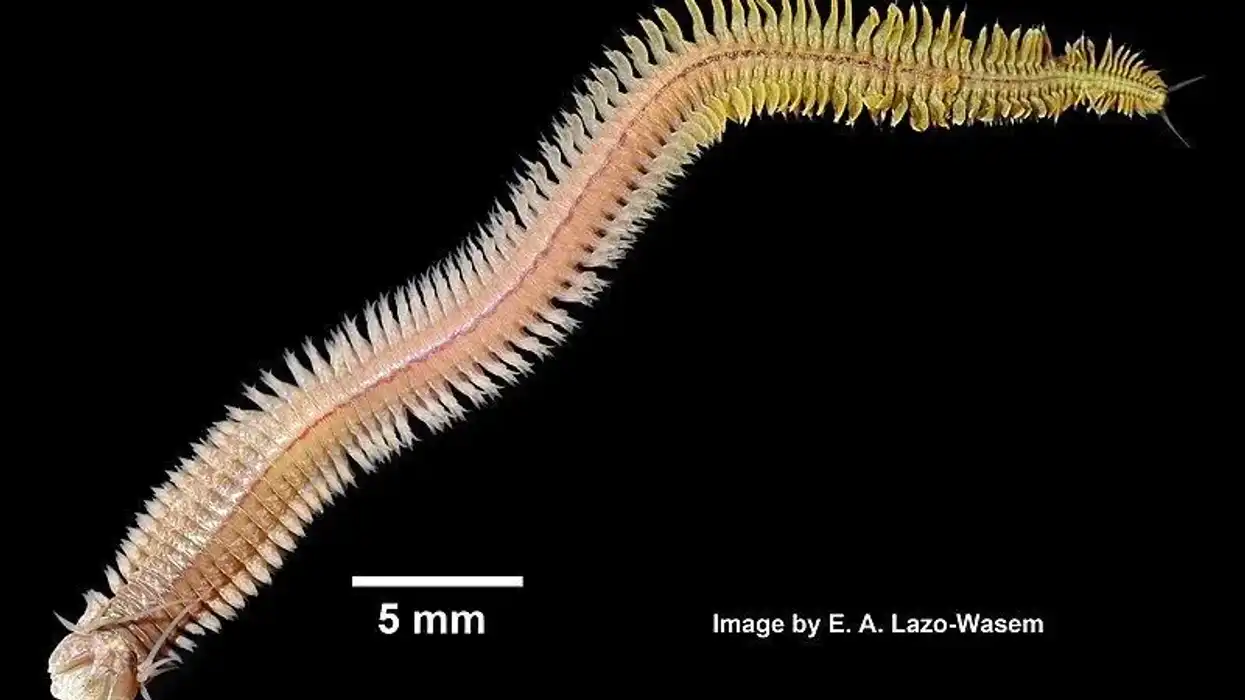Found mainly around southern Florida, Bermuda, Texas, and throughout the Caribbean sea, blue land crabs or Florida land crabs are a type of semi-terrestrial crabs, that is, they live both on land and in water, but spend most of their lives outside water.
These crabs are comparatively giant in size, measuring up to 6 in (15 cm), with one large claw and a small one.
Though, they are comparatively smaller than the Horseshoe crab and Spider crab. The males are usually bigger than the females and spend most of their lives inside their burrows.
These burrows are found at some distance from the shoreline and can sometimes be as deep as 2 yd (6 ft) and contain a puddle of water underneath to provide moisture.
Though blue land crabs are omnivorous, they mostly prefer vegetarian food like plants, leaves, berries, grasses. They even feed on insects and carrions.
These crabs are limited to a certain area given their sensitivity to cold weather. They are widely used as food in the regions like the Caribbean and Florida and are harvested on a large scale. These crabs produce offspring in very large amounts at once, hence, are used widely.
Given their giant size, they are not preyed upon much in adult life, the only animals that prey on these giant crabs are birds, humans, and other mammals (wild hogs, great blue herons). They are more prone to be preyed on in the larval stage by predators like sea nettle, juvenile bonefish, or French grunt.
The exploitation of these animals, however, has been a matter of concern for quite some time.
Florida has now put up a law that prohibits people from hunting down these crabs, especially during the mating season. Read on to discover fun facts about these crabs!
Blue Land Crab Interesting Facts
What type of animal is a blue land crab?
Blue land crabs are land crabs and are semi-terrestrial. They live mostly on land but can't live without water either.
What class of animal does a blue land crab belong to?
Blue land crabs are arthropods (just like honey bees) and belong to the class Malacostraca.
How many blue land crabs are there in the world?
It would be an impossible job to give an estimate of how many blue land crabs are there in the world, but their exploitation in the name of harvesting is a matter of great concern.
Female land crabs lay thousands of eggs at once, though, many of them fail to survive through the larval stage, it still looks like a 'crab invasion' when the rest of them take over a shore.
Where does a blue land crab live?
The blue land crab is mostly found in southern Florida, throughout the Caribbean, Texas, and Bermuda. It lives mostly on land, at a distance from the shoreline.
What is a blue land crab's habitat?
Blue land crabs are both marine and land crabs.
They spend most of their life in their burrows (just like rabbits) which they make at a distance from the shoreline, and because these burrows are sealed with mud, the atmosphere inside these burrows is high in carbon dioxide.
These crabs spend most of their lives inside their burrows and return to the ocean either to breathe or to migrate.
These crabs tend to be very possessive when it comes to their house, the fight for the best spot for a burrow often results in the losing crab migrating somewhere else.
Who do blue land crabs live with?
This species of land crabs digs its burrows in an area where there is a lot of mud, shrubs, or sand. This is the reason why these crabs have to share their homes with other insects, arthropods, or other small animals.
How long does a blue land crab live?
There is no definite data about the lifespan of a blue land crab, although, they do have a longer life compared to the other land crabs. If we had to provide an estimate, then the average lifespan of a blue land crab (Cardisoma guanhumi) would be somewhere around 11-13 years.
How do they reproduce?
Blue land crabs become sexually mature by four years of age. The reproduction cycle takes place around the month of June when it's the rainy season. The females migrate to the shore around the time of the full moon in search of a male.
The males come out of their burrows and the copulation takes place and then the fertilization happens. The number of eggs can range from 20,000-1,2,00,000.
The females carry these eggs on their backs for at least two weeks and then spawning them into the ocean. The spawning takes place when the eggs hatch. Then the ocean currents carry the hatched eggs until they are washed off on a random seashore.
What is their conservation status?
As of now, the blue land crabs (Cardisoma guanhumi) are not endangered. They are used as a food in the regions where they are mostly found, like the Caribbean and Florida.
Harvesting of this species of crabs is a matter of great concern because they are being exploited excessively in the Caribbean region. Keeping this in mind and to prohibit their exploitation, Puerto Rico has put up strict laws against the abuse these animals face.
Blue Land Crab Fun Facts
What do blue land crabs look like?
A blue land crab can be as big as 6 in (15 cm) and has two claws (pincers) which are different in size, one being comparatively much larger (can reach up to a size of 6 in or 15 cm) than the other one. The juveniles are brown in color with orange legs.
The adults, on the other hand, can either be blue or violet, their color ranges between these two.
Some female crabs show a white or an ashy gray color. The major difference between male and the female is that the males have a candlestick-shaped underbelly, whereas, females have a much broader underbelly.
How cute are they?
With two small eyes and a large body, the Cardisoma guanhumi may not be as cute as the dog next door, but it is pretty adorable, at least to some people.
How do they communicate?
There are various ways in which these crabs communicate. They have different ways to communicate depending upon the situation. Usually, they communicate through visual, auditory, or chemical signals.
When the reproductive period arrives, the females release pheromones to attract males. Not just this, these animals make use of the light from the horizon at dawn or dusk to locate themselves. These crabs also have setae (a stiff structure resembling a hair or a bristle) on their appendages and these are highly sensitive to vibrations.
How big is a blue land crab?
The blue land crab can grow up to a size of 6 in (15 cm) and weighs something around 17 oz (500 g).
How fast can a blue land crab run?
As these crabs live on land and have to keep themselves safe, they are pretty fast runners.
How much does a blue land crab weigh?
The blue land crab can weigh up to 0.8-1.3 lb (0.4-0.6 kg).
What are the male and female names of the species?
There is no specific name for males and females separately, they are collectively called blue land crabs or by their scientific name Cardisoma guanhumi or commonly called Florida land crabs.
What would you call a baby blue land crab?
A baby blue land crab is called zoea.
What do they eat?
A blue land crab usually prefers vegetarian food, plants, berries, and grass, but it often preys on smaller insects and carrions.
Conversely, the blue land crab can be eaten itself. You can eat blue land crabs in Florida. Adult blue land crab is enjoyed as a delicacy in places like the Caribbean and Florida.
Are they poisonous?
Blue land crabs are not poisonous but they may contain toxins within their internal organs. Their body does not produce its own poison. It is also advised to just eat the claw and the leg meat of land crabs leaving out the internal organs because they may turn out to be poisonous.
Would they make a good pet?
As these crabs are semi-terrestrial and live in burrows as deep as 2 yd (6 ft.), they may not be the right choice of animal to keep as a pet like a Poodle dog but if put under proper care and provided with all the requirements, they could be adopted as a pet.
Did you know...
Though these crabs have lived on the land for generations now, evolution hasn't helped them in any way. Blue land crabs breathe through gills, and in order to keep their oxygen level at an optimum level, they have to keep their gills moist.
They spend most of their lives inside their burrows, but they still have to come out to go in the water for oxygen or at least build their burrows near to the shoreline for the water to seep in.
Just like the hermit crab, or any other crab species, blue land crabs can also regrow their limbs during subsequent molts. This process is often called declawing.
Where can I find blue land crabs in Florida?
Florida land crabs are usually found in the southern side of Florida near the shores. They reside at least 5 mi (8 km) away from the shoreline where they make their burrows which are almost 2 yd (6 ft) deep.
Can blue land crabs swim?
As the Cardisoma guanhumi is a semi-terrestrial animal, it spends its life both on land and in water. Even though they have to get into the water at some point, these crabs cannot swim very well.
Learn more about some other arthropods from our Vinegaroon facts and Boll Weevil facts pages.
You can even occupy yourself at home by coloring in one of our free printable Blue land crab coloring pages.










